How might climate change affect a place like the Sonoran Desert, whose bi-modal precipitation regime is the primary cause of the area’s amazing species and lifeform diversity? The Sonoran Desert Network is monitoring several vital signs that will likely show the effects of climate change. Below is a summary of the network’s local-scale findings to date, as well as some examples of how monitoring will detect future change.
The Sonoran Desert and its “sky islands” are unusually situated at the boundary of the southernmost habitat for temperate species and the northernmost habitat for tropical species. As such, the area is home to a unique assemblage of flora and fauna that has responded to previous climatic changes. Over the past 14,000 years, many species have established and flourished, and others have been extirpated.
The Sonoran Desert Network (SODN) is one of 32 National Park Service inventory and monitoring networks that have implemented vital signs monitoring to assess the condition of park ecosystems and develop a stronger scientific basis for stewardship and management of natural resources across the National Park System. SODN is monitoring several vital signs that will likely show the effects of climate change. Below is a summary of the network’s local-scale findings to date, as well as some examples of how SODN monitoring will detect future change.
Current Findings
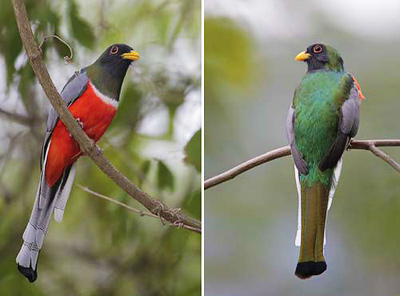
© Greg Lavaty
Bird Species Found North of its Historical Range
In 2008 and 2009, Sonoran Desert Network landbird monitoring detected elegant trogons (Trogons elegans) nesting at both units of Montezuma Castle National Monument. The park is located in north-central Arizona, several hundred miles north of the previously documented distribution for this beautiful and distinctive tropical species, which was previously thought to extend only to the borderlands of southeastern Arizona. It is believed that milder winter and spring seasons linked to climate change may have permitted an extension of this species north, to exploit the riparian environments of the Verde Valley just south of Flagstaff, Arizona.

Alice Wondrak Biel / NPS
Vegetation Change at Saguaro National Park Indicates Shift Toward Warm-season Plants
To support the development of a vegetation monitoring protocol, staff at the Sonoran Desert Network and Saguaro National Park located and remeasured permanent vegetation plots established in 1976, in the Cactus Forest area of Saguaro National Park. Designed to document potential grazing effects on native vegetation, this extensive study instead illustrated a major increase in the abundance of shallowrooted subshrubs, grasses, and other herbs, at the expense of deeper-rooted trees and shrubs. Deeper-rooted species are primarily supported by cool-season precipitation, whereas shallow-rooted species tend to take advantage of the brief, intense pulses of moisture following summer thunderstorms. These shifting vegetation patterns mirror changes in seasonal precipitation measured over the last 30 years, illustrating the close linkages between ecosystems and the bi-modal precipitation regime that defines the Sonoran Desert, and tracking predicted regional effects of global climate change.

G.M. Stolz / USFWS
Sharp Decline in Four Amphibian Species at Gila Cliff Dwellings National Monument
Intensive field surveys of amphibians, conducted as part of the SODN biological inventory at Gila Cliff Dwellings National Monument, indicate the probable loss of four species (Chiricahua leopard frog, Mexican spadefoot toad, Woodhouse’s toad, and red-spotted toad) from the park—species that were commonly encountered during equivalent field surveys in the early 1970s. Many factors have likely contributed to this apparent extirpation, including the presence of aggressive non-native species, drought, and chytrid fungus; however, all of these stressors are relatively minor in this area relative to similar areas elsewhere in the American Southwest. However, increased UV radiation, associated with decreased atmospheric ozone and a problem of great significance in the alarming recent decline of amphibians worldwide, may be the primary reason for the loss.

J. Boles / NPS
Local Effects of Climate Change Affect Fauna at Organ Pipe Cactus National Monument
Ecological monitoring at Organ Pipe Cactus National Monument has documented increased air temperatures and increasingly erratic precipitation since the 1950s, with important consequences for park fauna. Warm-month (three summer months) average daily air temperature has steadily increased by approximately 4°F since 1950, and cold-month (three winter months) average daily temperatures have increased slightly more than 8°F over the same period. As a result, the annual number of freezing days at the park has plummeted from about 28 in the 1950s to just 5 in 2006. Recent analysis of temperature and precipitation, in conjunction with 17 years of biological monitoring data, indicates that community and population dynamics of lizards and small mammals at Organ Pipe Cactus NM are tightly coupled to precipitation patterns, with feedbacks to cactus ferrugious pygmy owls, a rare predator species.
How Monitoring Will Detect Climate Change

Alice Wondrak Biel / NPS
Seeps, Springs, and Tinajas
Water and water-dependent ecosystems are scarce resources in the arid and semi-arid southwest, and are generally regarded as biodiversity hotspots. Seeps, springs, and tinajas are critical surface water sources in the arid and semi-arid Sonoran Desert and Apache Highlands ecoregions. These waters are also among the most restricted habitats for focal and threatened plant and animal species. They are the primary interface between groundwater and surface water, and serve as important water sources for park fauna and flora. Precipitation is critical to their existence, and the size, frequency, and duration of precipitation events are key factors influencing spring-water availability. Climate change is expected to alter ground and surface water quantity, as well as seasonal patterns of flooding and drought, and springs will be a direct indicator of these changes. Monitoring seep, spring, and tinaja ecosystems will enable a more thorough understanding of the impacts of human activities on these ecosystems.
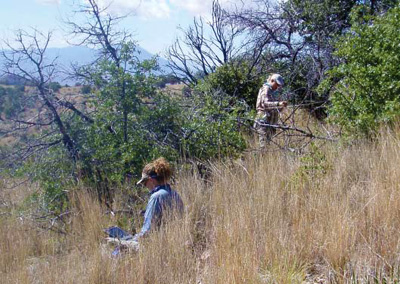
NPS
Uplands
Global climate change is expected to alter the type (e.g., rain versus snow) and amount of precipitation and the seasonality of large precipitation events, with unknown implications for upland systems. Predicted increases in temperature may increase physiological stress in trees, leading to greater susceptibility to infestation by insects and pathogens, and can also alter the elevation domain of species, leading to the migration of forest communities farther upslope (e.g., desert scrub would replace the lowest extent of grassland and shrubland, which would in turn replace lower areas of woodland and forest). This would result in major implications for the mixed-conifer ecosystems and animals that occur near the crest of the sky islands, as there are no higher habitats into which they can migrate. SODN upland monitoring was designed to to ascertain broad-scale changes in vegetation and dynamic soils properties in the context of changes in other ecological drivers, stressors, and processes, including climate.
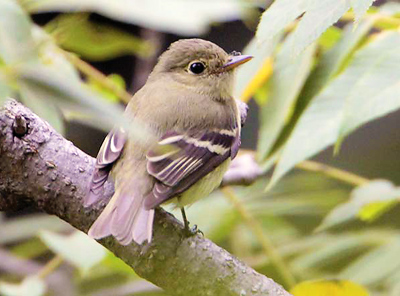
© Greg Lavaty
Landbirds
Because they can respond quickly to changes in resource conditions, changes in landbird populations may indicate changes in the biotic or abiotic components of the environment upon which they depend. Despite being relatively mobile, birds would likely be signifi cantly aff ected by climate change, as many require existing high-elevation biomes for key portions of their life cycles. Of the 198 bird species documented in Saguaro NP’s Rincon Mountain District, 20 (10%) have been observed only at high-elevation sites. Some notables include the yellow-eyed junco, mountain chickadee, spotted towhee, and cordilleran fl ycatcher. Bird monitoring data can be used to ascertain the overall natural condition of SODN parks, and can provide insights into the potential consequences of stressors, such as climatic change.
Invasive Exotic Plants
Climatic changes are predicted to provide exotic plant species with new opportunities for invasion. Because they fragment native ecosystems, displace native plants and animals, and alter ecosystem function, invasive exotics represent one of the most serious threats to natural ecosystem integrity. They can also alter fi re regimes, for instance, by causing fi res to burn more swiftly or intensely, or even introducing fi re to systems that did not evolve with it. Data from the National Interagency Fire Center indicate that wildfi res on western lands have increased signifi cantly in the past 10 years, and several climate models predict that climate change will result in more frequent and extreme droughts that could episodically reduce water availability and soil moisture. An increase in exotic invasions, in combination with the decreasing soil moisture that may accompany climate change, could set the stage for fi res with the potential to dramatically impact desert and aquatic ecosystems. SODN monitoring of invasive exotics as part of its monitoring protocols for uplands and washes provides park managers with data on early detection of these species, which should allow them to deal with invasive exotic plant species eff ectively in the face of climate change.
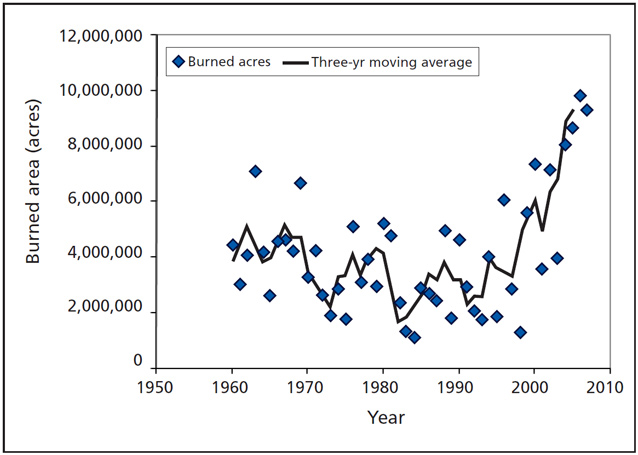
NIFC
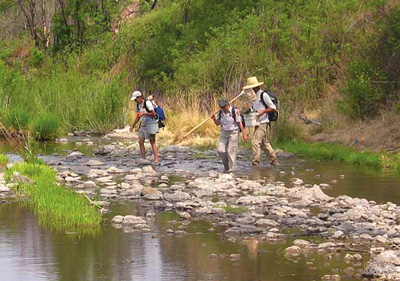
NPS
Streams
Sonoran Desert Network parks contain reaches of some of the major rivers in the American Southwest: the Gila, Santa Cruz, and Verde. The condition of these rivers within SODN parks is greatly influenced by drivers and stressors occurring over broad watersheds and upstream segments located well beyond park boundaries. Climate change may have direct and indirect effects on streamflow and water quality. As temperature and precipitation patterns aff ect the abundance, type, and distribution of vegetation cover in watersheds, changes in flood magnitude and duration, sediment loads, and water chemistry will occur. SODN monitoring of water quality and chemistry; channel morphology; riparian plants; macroinvertebrates; and stream discharge will allow park managers to address proximate issues occurring within park boundaries and will also provide an index of overall watershed condition.
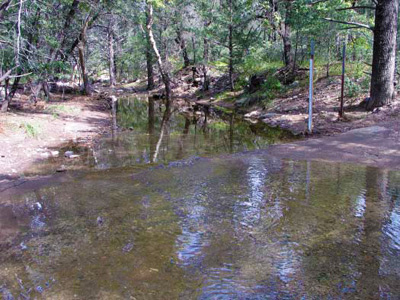
NPS
Washes
Ephemeral and intermittent drainages serve as critical habitat and travel corridors for resident and migratory species in the Sonoran Desert and Apache Highlands ecoregions, and provide important ecosystem services, such as flood dissipation, sediment transport, and habitat connectivity. Washes are solely dependent on precipitation for streamflow, which will make these systems and their associated plant communities highly susceptible to the variations in precipitation that are expected to accompany climate change. The SODN will monitor channel morphology and riparian vegetation in wash areas.

NPS Photo
Groundwater
In the Sonoran Desert, groundwater is the source of most surface water bodies. Availability of groundwater also has critical consequences for flora, fauna, and nutrient, water, and energy flows. In many parts of the American Southwest, long-term drought and human development have already led to significant declines in groundwater levels at local and regional scales. Impacts to groundwater resources associated with reductions in infiltration and storage, often related to soil loss and changes in surface characteristics, can be directly addressed by management actions aimed at soil conservation and recharge enhancement. The possibility of a reduction in precipitation recharge related to climate change, however, would be far more problematic and have the potential for broad-scale impacts to surface-water systems.
For more information
Sonoran Desert Network
National Park Service
7660 E. Broadway Blvd, Suite 303
Tucson, Arizona 85710
https://www.nps.gov/im/sodn/index.htm
Prepared by the Sonoran Desert Network Inventory and Monitoring Program, 2010.
Last updated: June 4, 2021
